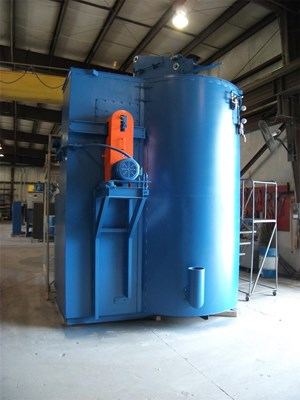
Pit Furnaces: The Swiss Army Knife of Heat Treating
Posted on August 29, 2019 in Blog

Manufacturers often refer to pit furnaces as the “Swiss Army knife” of heat treating. Swiss Army knives are world renowned for their versatility and usefulness, and the same is true for pit furnaces. Also known as top loading furnaces, pit furnaces are easy to use, cost effective, and energy efficient. Pit furnaces are also versatile, in that they can perform two important heat treatment processes: gas nitriding and carburizing. This versatility is what makes the pit furnace an essential part of any heat treatment application.
Surface Hardening = Improved Durability
Surface hardening, also known as case hardening, increases the durability and hardness of metal components. Nitriding and carburizing are the two most common heat treatment practices for surface hardening functional components, and pit furnaces perform them both.
Gas nitriding and carburizing seem similar at first glance, as both increase durability and hardness, but there are differences between the two. Both nitriding and carburizing diffuse atoms onto the surface of the parts undergoing processing; the extra layer of atoms creates a protective case. The main difference is that nitriding diffuses nitrogen atoms and carburizing adds carbon atoms.
Gas Nitriding Process
The gas nitriding process involves introducing a nitrogen-rich gas, usually ammonia, to a work piece. When the ammonia contacts the heated work piece, it breaks into hydrogen and nitrogen. The nitrogen then spreads onto the surface of the work piece, creating a layer of nitride.
Items are loaded into the chamber of a pit furnace. Heating elements raise the temperature inside the chamber; thick insulated walls and a computer control system maintains consistent temperatures throughout the process. When the work piece reaches a predetermined temperature, an ammonia dissociator introduces ammonia into the chamber. Gas nitriding requires relatively low temperatures, so quenching is usually unnecessary.
Carburizing Process
Carburizing works in much the same way as gas nitriding – by heating components in a pit furnace and introducing carburizing gases at temperature. Unlike gas nitriding, though, carburizing occurs at higher temperatures and the finished components therefore require quenching. Carburizing imparts deep cases, which are particularly useful for large components.
Precise Process Control
Manufacturers have been performing gas nitriding and carburizing for decades, but advances in pit furnaces have improved the thermodynamics and kinetics involved in creating high quality finished components. Today’s pit furnaces allow users to select the thickness and the constitution of each nitriding and carburizing layer, and provide for greater control over temperatures. Computer control of the atmosphere inside the pit furnace results in closely controlled nitriding and carburizing results. Because of their versatility, ease of maintenance, and cost-effectiveness, pit furnaces are indeed the Swiss Army knife of thermal processing.
For more information about pit furnaces and other Lindberg/MPH equipment call us at 269.849.2700. Like Lindberg/MPH on Facebook and follow us on LinkedIn to stay up to date with industry and company news.

